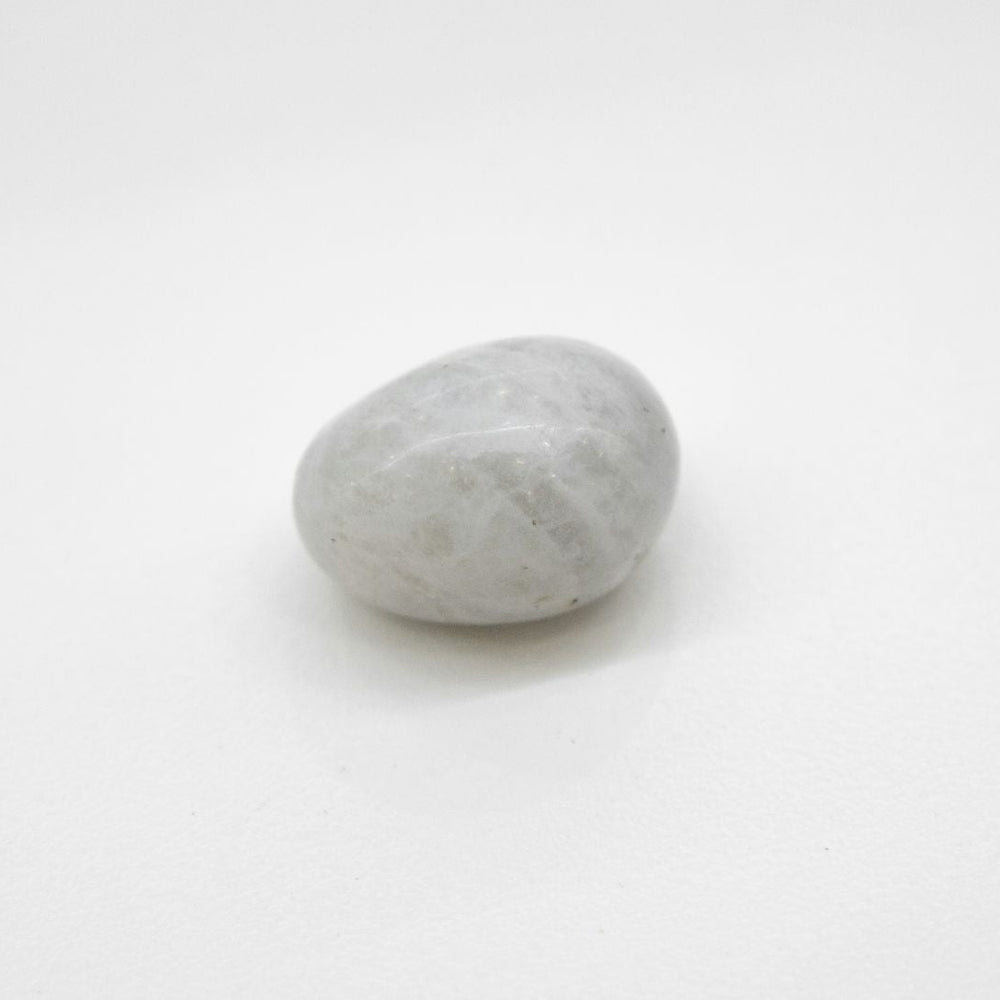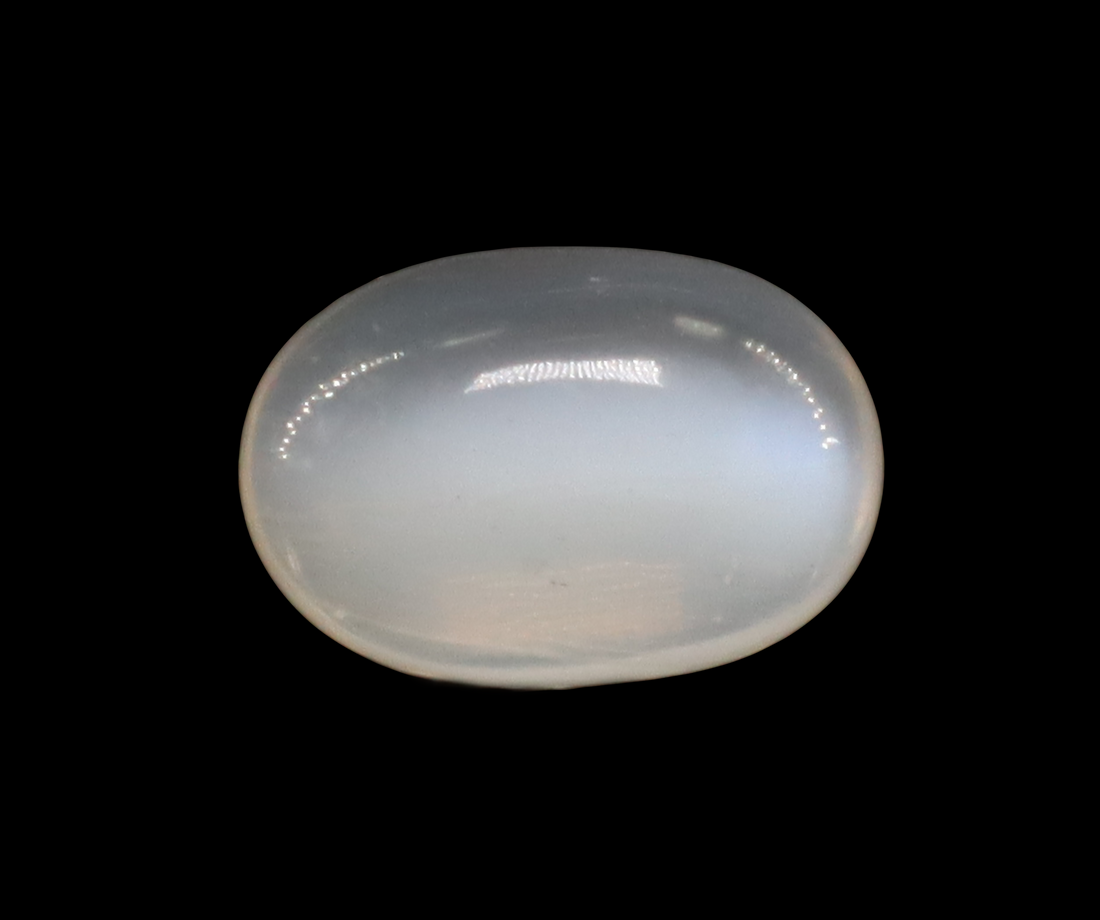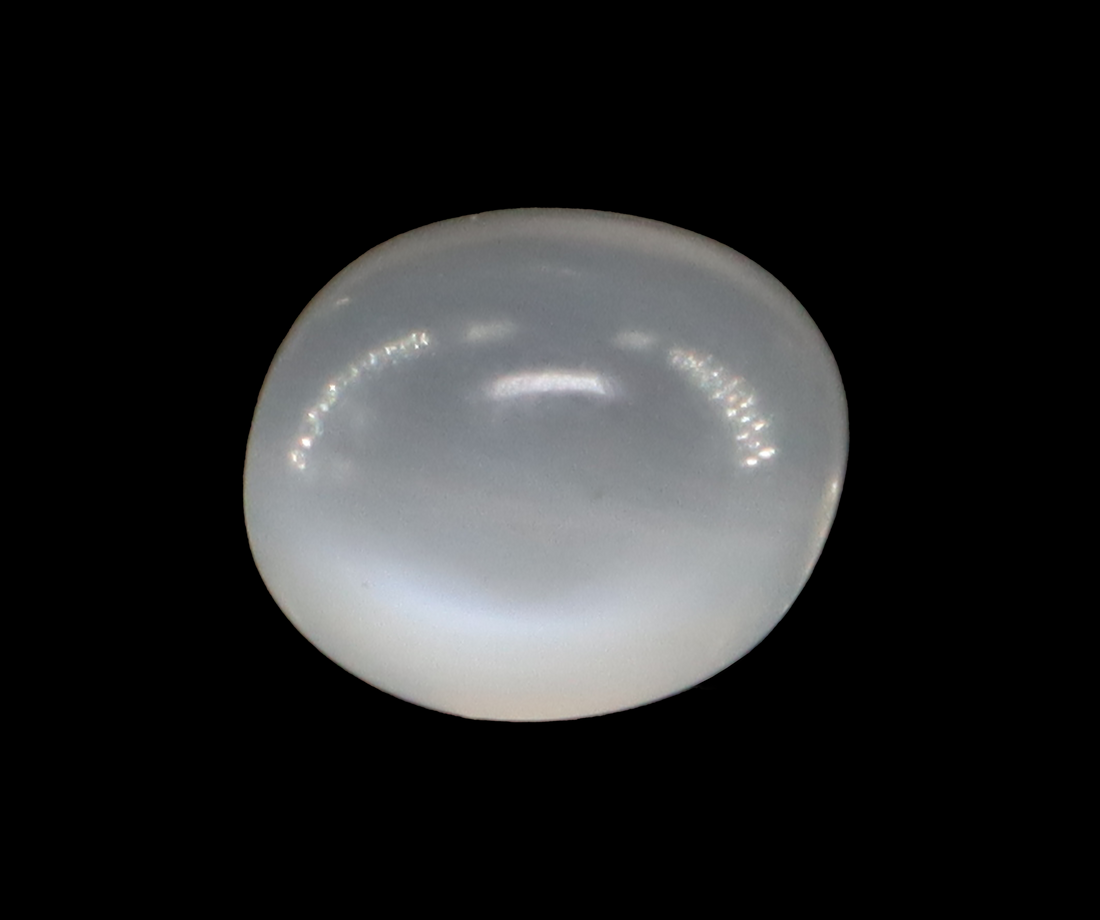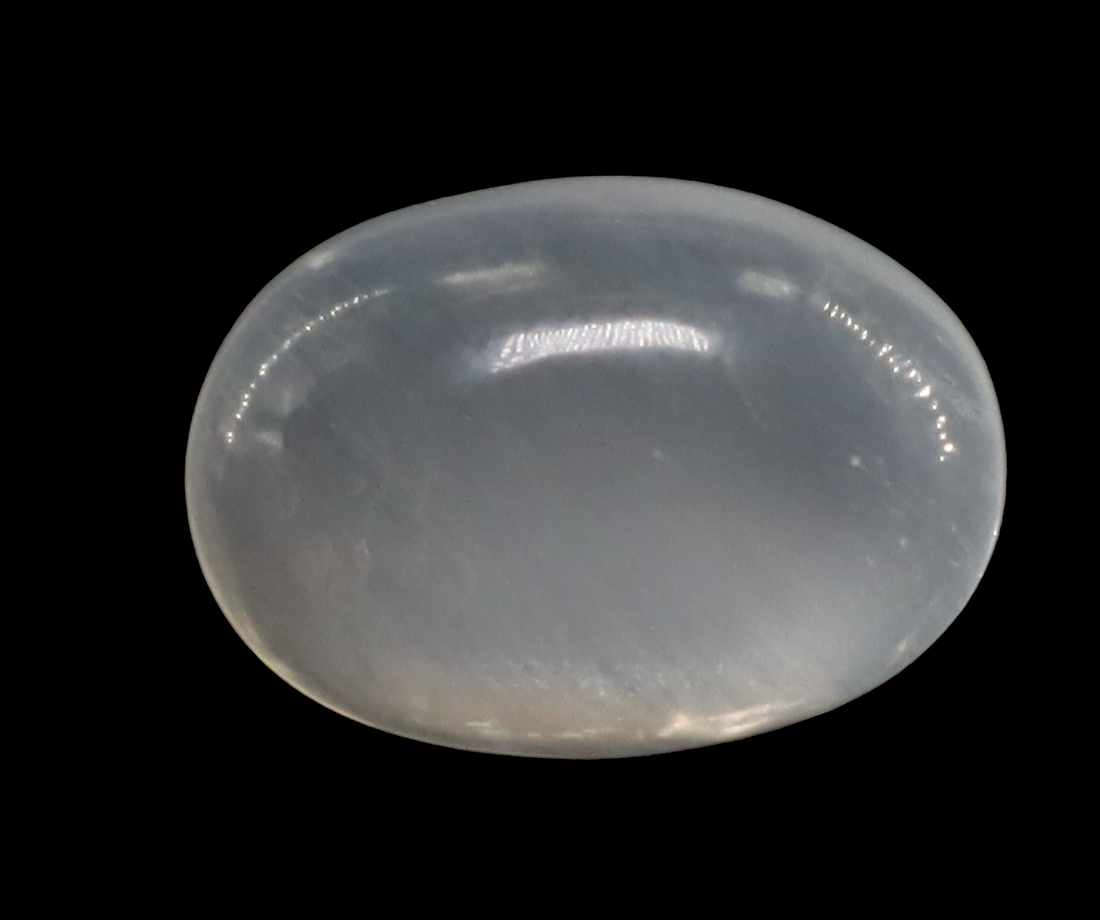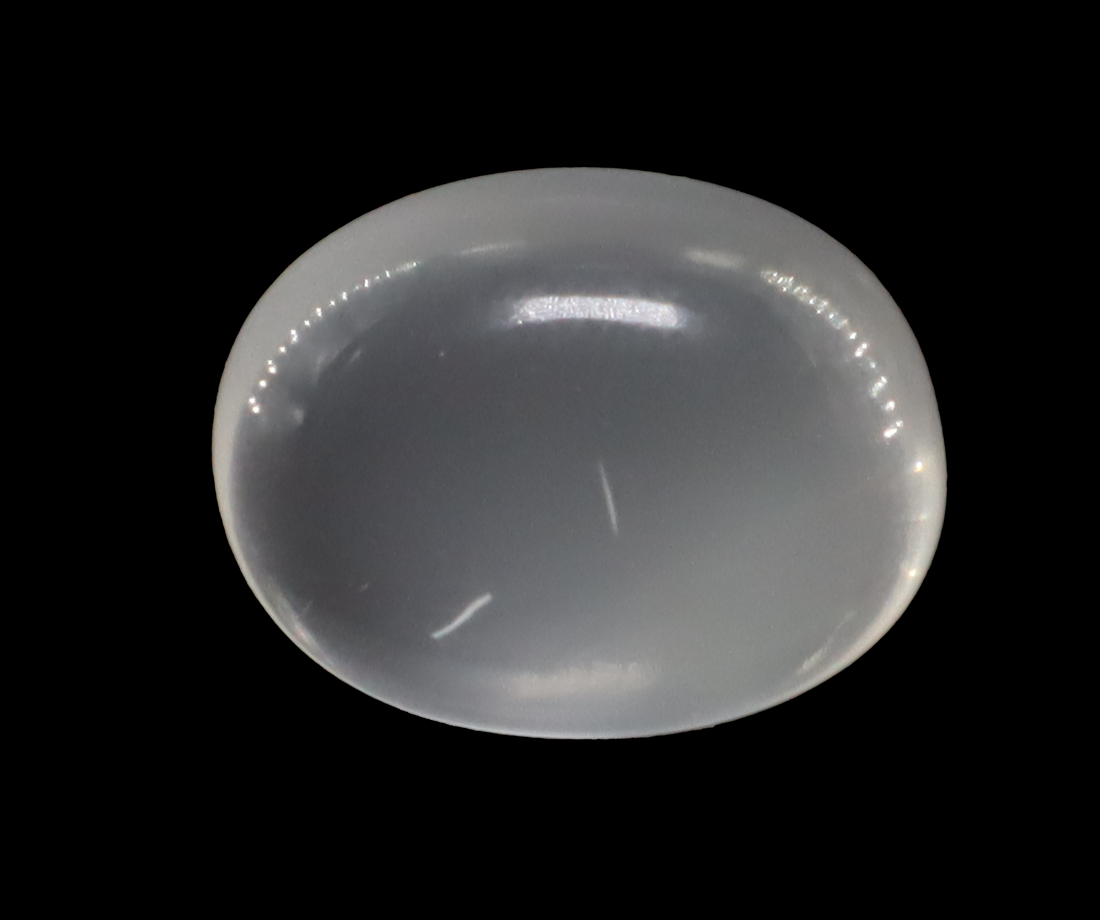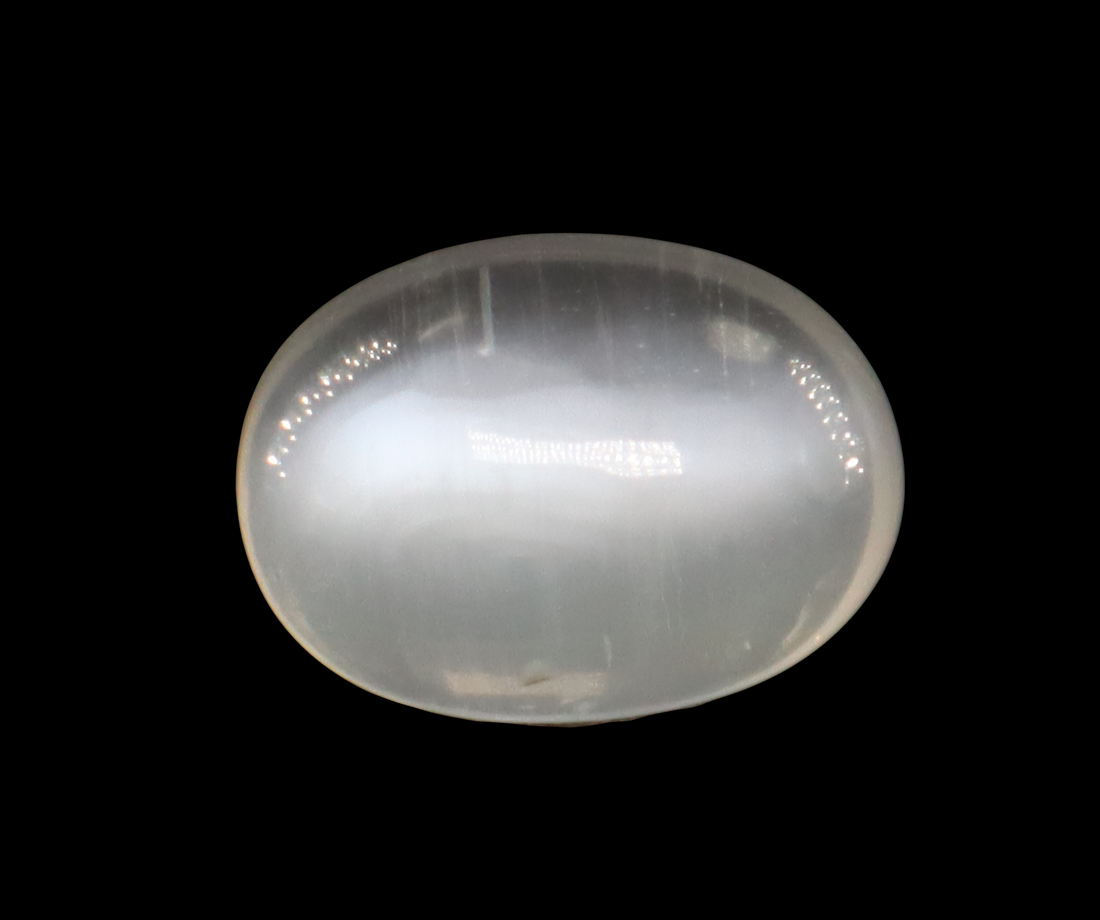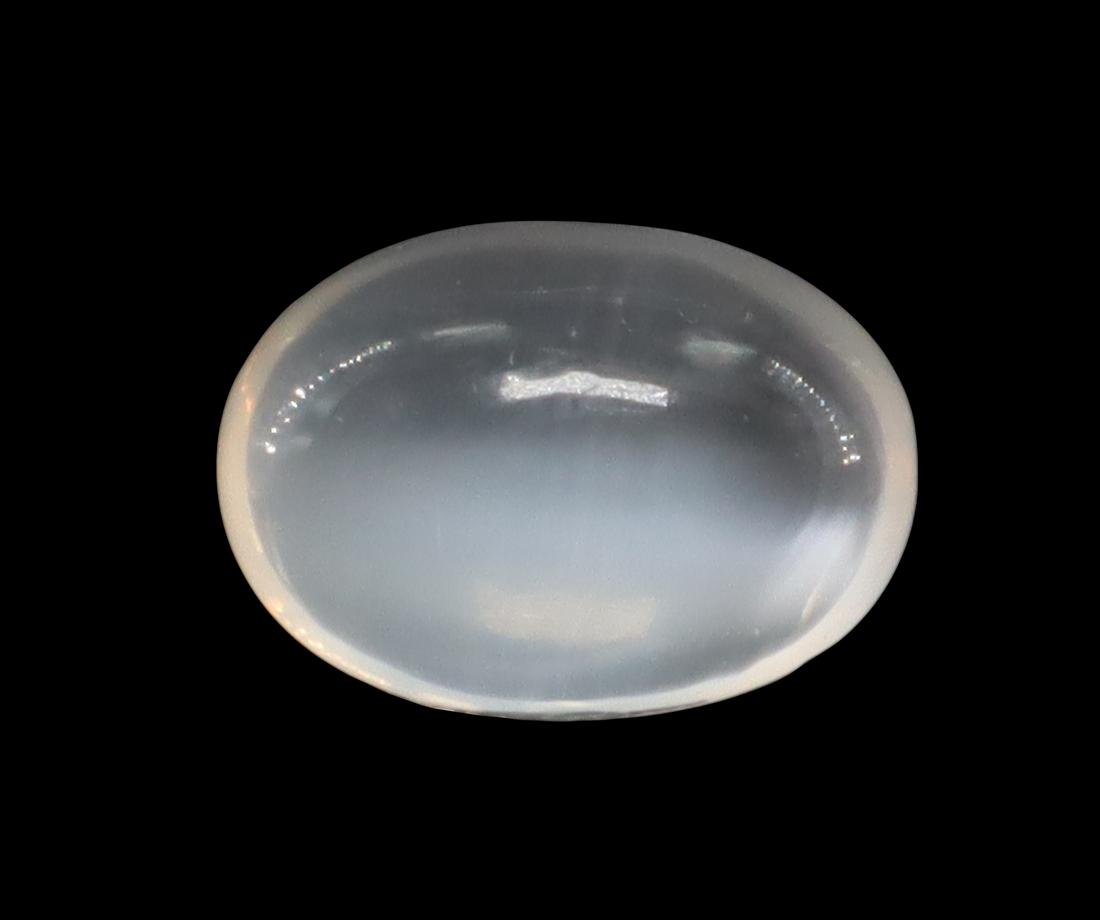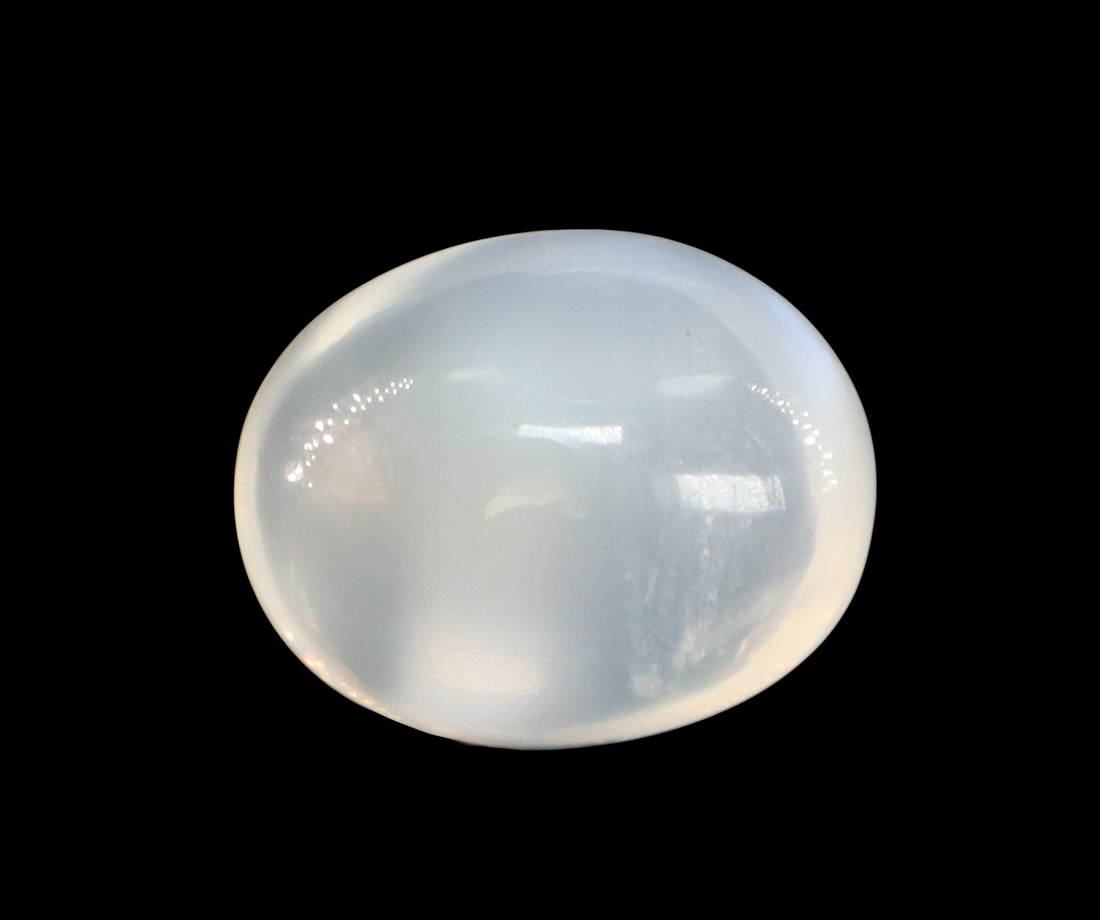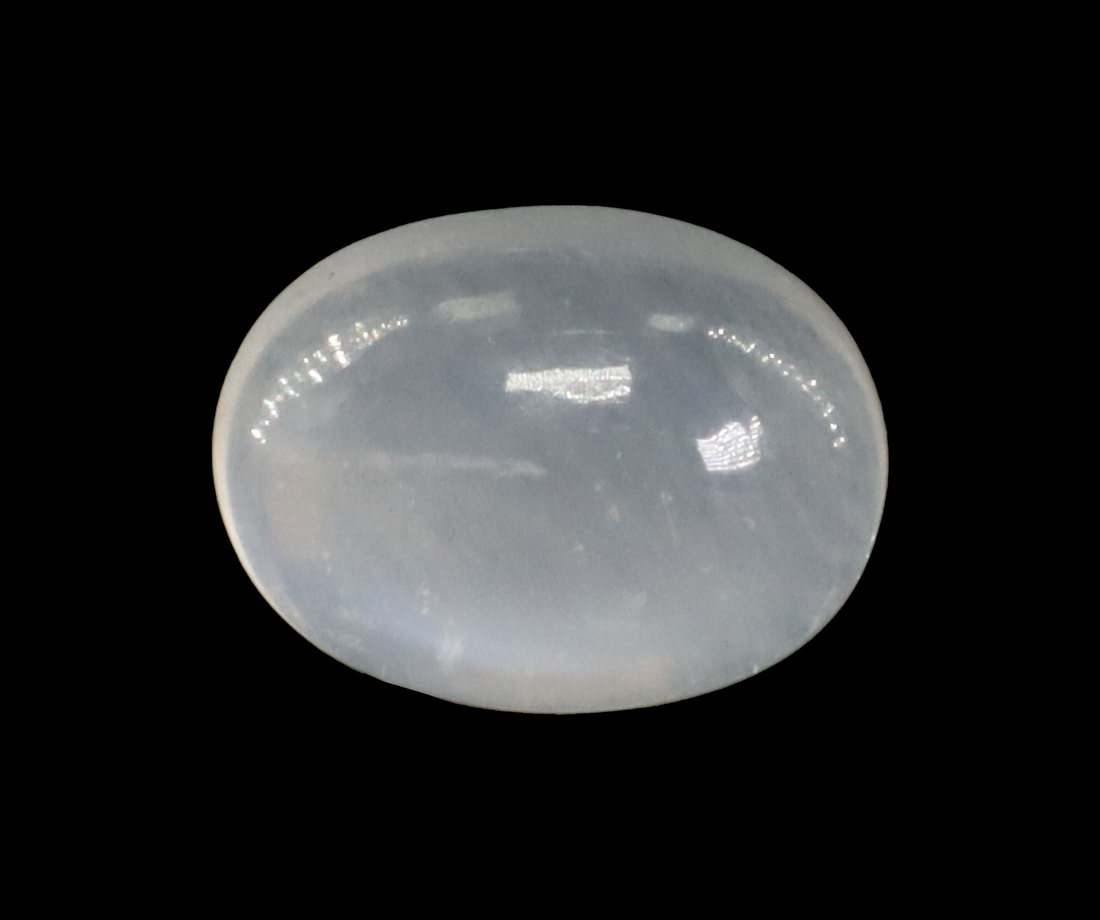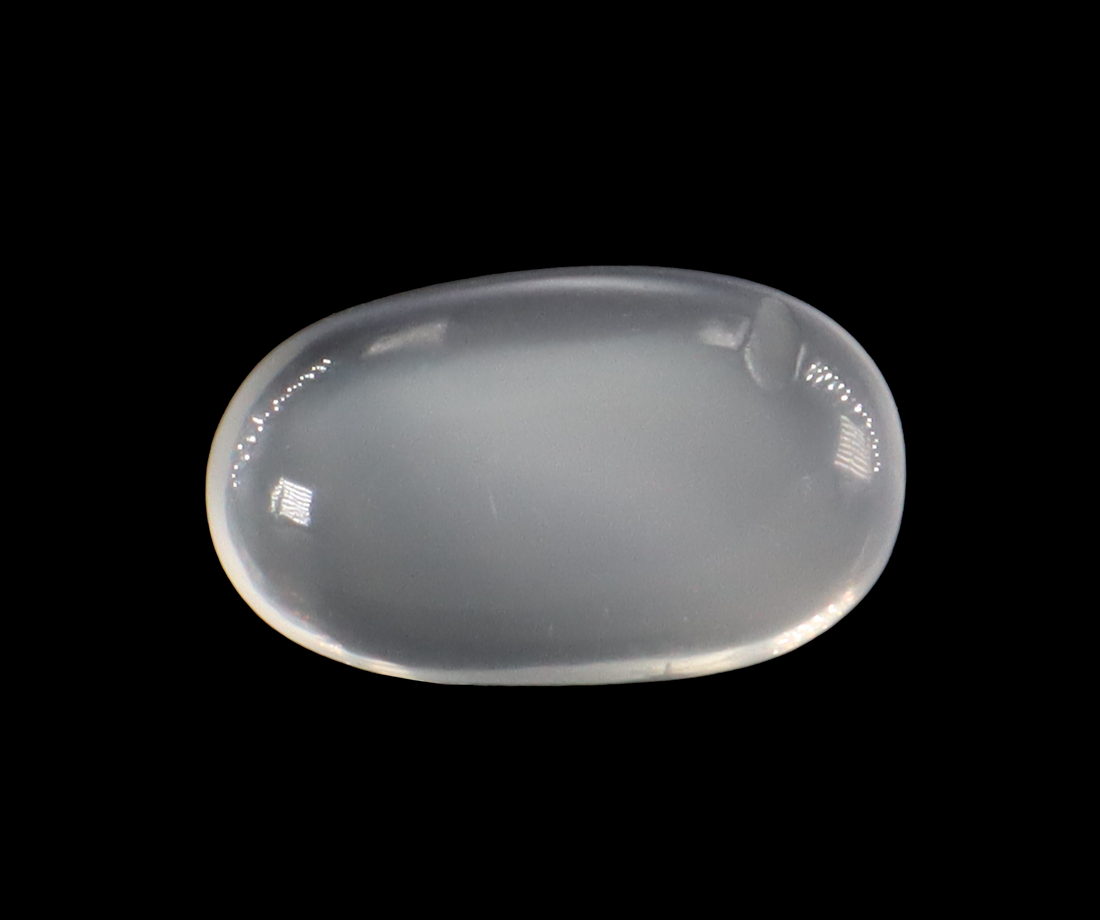This article serves as part of an ongoing series of profiles on the different varieties of precious & semi-precious gemstones. To view the entire list, click here.
Moonstones, the gem variety of the feldspar group of minerals, have captivated humanity for centuries with their ethereal glow and enchanting aura. Renowned for their unique play of light and mesmerizing colors much like opal stones, moonstones hold a timeless allure that extends beyond their aesthetic charm. As an alternative birthstone for June alongside pearls and Alexandrites, moonstone gems are celebrated for their blue-to-white adularescence, reminiscent of a billowy, moonlit sheen. Widely distributed across the globe, moonstones have earned their place as a popular choice in jewelry, offering a calming and versatile gemstone option.

Rough Moonstones
In this comprehensive guide, we will delve into the intriguing world of moonstones, exploring their formation, occurrence, and various aspects that make them truly special, including inclusions, treatments, pricing, and their significance in astrology. Join us on a journey to uncover the mysteries and beauty that make moonstones a captivating gemstone choice for jewelry enthusiasts and collectors alike. Here is everything you need to know about moonstones.
1. Moonstones - Formation & Occurrence
Moonstone, a captivating gem, belongs to the feldspar mineral orthoclase. Its enchanting appearance is a result of its formation in magmatic and metamorphic environments, often within pegmatites, making it a distinctive and highly sought-after gemstone. Moonstones are primarily composed of potassium, aluminium, and silicate. The gem derives its name from the unique sheen it displays, reminiscent of the Moon's glow. This distinctive feature adds to the allure of moonstones, making them a remarkable and symbolic addition to the world of gemstones.
This captivating journey unfolds beneath the Earth's surface, where moonstone undergoes a transformative process. The gem exhibits a mesmerizing optical phenomenon known as adularescence—a milky and bluish glow that seems to dance and billow across its surface. This effect is achieved as orthoclase and albite, the minerals comprising moonstone, separate into alternating layers. When light permeates these thin layers, it scatters, creating the alluring adularescence that defines moonstones.
 Moonstones are known for the Adularescence optical effect they exhibit
Moonstones are known for the Adularescence optical effect they exhibit
2. Where Are Moonstones Found?
Moonstones are generally abundant relative to other gem species, and occur in various regions across the world. Moonstones from different origins showcase distinct characteristics; here's a more detailed exploration of notable deposits in various countries:
- India: India is renowned for producing a variety of moonstones, with the most notable being the rainbow moonstone. This type displays a captivating array of colors, including blue, and green, due to the presence of albite and other mineral inclusions. The country's moonstone deposits, particularly in regions like Rajasthan and Bihar, contribute to the gem's diverse color spectrum.
- Sri Lanka/Ceylon: Ceylon, often hailed as a significant source of high-quality moonstones, yields stones with a distinctive blue sheen. The blue moonstones from Sri Lanka, also known as Ceylon moonstones, are highly valued for their intense and cool blue adularescence. The country's mining areas, such as Meetiyagoda, are particularly known for these captivating gems.
- Madagascar: Moonstones from Madagascar are recognized for their larger crystal sizes and unique color play. These stones often exhibit a milky-white adularescence and can also feature shades of peach and orange. Madagascar's moonstone deposits contribute to the gem's overall diversity, providing collectors with a broad spectrum of options.
- Myanmar/Burma: Myanmar is a source of moonstones known for a velvety blue adularescence in Burmese moonstones. These gems are esteemed for their rich color and are found in regions like Mogok. The country's moonstone deposits add a touch of exclusivity to the market, as they are known for their exceptional clarity and intense blue hues.
- United States of America: In the United States, moonstones are primarily found in areas like New Mexico and Pennsylvania. The American variety often displays a silvery-white sheen and is valued for its unique charm. While the production may not be as extensive as in other countries, American moonstones are appreciated for their individual character and are commonly used in artisanal moonstone jewelry like bracelets, moonstone rings and more.
3. The Colour Span of Moonstones
Moonstones present a captivating palette of colors, encompassing shades like blue, peach, grey, and an enchanting spectrum of rainbow moonstone hues. The gem's signature glow, known as adularescence, is a mesmerizing play of light influenced by factors such as the stone's composition and the angle of incident light. Among the most coveted moonstones are those exhibiting a radiant blue sheen, often referred to as "blue moonstones". This captivating effect is a result of light interference within the crystal structure, creating a remarkable play of hues. Additionally, some specimens boast a metallic blue shimmer, adding a layer of allure to these extraordinary gems.
Moonstones showcase a diverse range of appearances, from semi-transparent to opaque, and their color variations span from colorless to white, with adularescent effects in blue, silver, or white. While the most prized moonstones display the iconic blue sheen, it's important to note that the gem's body colors can vary widely. Moonstones may manifest in shades of green, yellow to brown, or gray to nearly black, offering collectors a broad spectrum of choices. Intriguingly, alongside adularescence, certain moonstones exhibit chatoyancy, commonly known as the cat's eye effect, which adds a dynamic visual element. A select few moonstones even showcase a four-rayed star in an effect referred to as asterism, further enhancing the gem's mystical and unique allure.
 Different colors of a moonstone
Different colors of a moonstone
4. Common Inclusions in a Moonstone
The allure of moonstones lies not only in their radiant beauty but also in the inherent charm of their characteristic inclusions. One of the distinctive features found within moonstones is the presence of tiny tension cracks, affectionately known as "centipedes." These minute cracks contribute uniquely to the stone's appearance, adding an intriguing element to its overall character.
Centipede inclusions, resembling delicate fractures, meander across the surface of the moonstone, creating a captivating visual effect. The name "centipedes" aptly captures their sinuous and linear patterns, enhancing the gem's authenticity and individuality. What makes centipede inclusions particularly fascinating is their interaction with the crystal layers of the gem. As these tiny fractures intersect with the layers within the moonstone, they play a crucial role in enhancing the adularescent effect. Familiarizing oneself with these natural features becomes a key aspect of appreciating the genuine nature of the moonstone.
 Centipede inclusions in a Moonstone (Source: GIA)
Centipede inclusions in a Moonstone (Source: GIA)
5. Common Treatments & Enhancements of Moonstones
Moonstones, valued for their natural beauty, may undergo treatments to enhance color or clarity, although untreated stones are generally preferred within the industry. Here's an overview of common treatments and their effects:
- Heat Treatment/Thermal Enhancement: Heat treatments are frequently employed to enhance the color of moonstones. This process involves exposing the gem to controlled temperatures, intensifying its natural hues. It is important to note that this treatment aims to improve color while preserving the stone's intrinsic properties.
- Surface Coating: Some moonstones undergo surface coating to enhance their appearance. This treatment involves applying a thin layer of material like polymer resins, oil and or wax to the stone's surface to achieve specific visual effects.
- Irradiation: Irradiation is another treatment method used to improve the appearance of moonstones. This process involves exposing the gem to controlled radiation to alter its color.
Understanding these treatments is crucial for consumers to make informed decisions. While heat treatments are generally accepted within the industry, surface coatings and irradiation may have implications on the gem's long-term durability and should be disclosed by reputable dealers. Transparency in disclosing treatments ensures that consumers can fully appreciate the authenticity and characteristics of the moonstone they choose.
| Mineral | Feldspar |
|---|---|
| Colour Span | Colorless to White, Gray, Green, Peach, Brown, etc. |
| Popular Origins | India, Sri Lanka (Ceylon), Myanmar (Burma), Madagascar, United States, etc. |
| Mohs Hardness | 6.00 - 6.50 (on a scale of 10) |
| Common Treatments | Heat treatment, Surface Coating, & Irradiation |
| Birthstone | June |
Moonstones - A Quick Snapshot
6. Evaluating the Quality of a Moonstone
Assessing the quality of a moonstone involves considering various factors. The 4Cs – Color, Clarity, Cut, and Carat Weight are pivotal in determining a gem’s value. Additionally, the origin of the moonstone plays a significant role, as stones from certain regions may possess unique characteristics that distinguish them from others.
- Color: Moonstone, a predominantly colorless or white gem, is renowned for its captivating adularescence effect, commonly known as a blue sheen. However, it occurs in a spectrum of distinct hues, including grey, green, peach, and brown. The most exceptional moonstones boast an electric blue shimmer. Throughout its extensive history, a consensus has emerged regarding the qualities that define highly prized moonstones. These gems are characterized by a colorless to nearly transparent appearance, devoid of visible inclusions. The most sought-after moonstones exhibit a vivid blue adularescence, often referred to as a blue sheen. The epitome of moonstone perfection is a gem of glassy purity, showcasing a mobile, electric blue shimmer. For optimal value, a moonstone's body color should be nearly colorless, free from any yellowish, brownish, or green tints. The ideal adularescence is blue, and it should be prominently centred on the top of a cabochon. Furthermore, this enchanting sheen should be easily visible from a wide range of viewing angles. Notably, if a moonstone's adularescence is confined to a restricted viewing range, its value diminishes.
- Clarity: Moonstone exhibits a clarity spectrum ranging from transparent to opaque. The highest quality moonstones are characterized by a flawless appearance, free from any eye-visible inclusions. Optimal moonstone clarity entails near transparency, striving to be as inclusion-free as possible. This emphasis on clarity is crucial as inclusions have the potential to disrupt the captivating adularescence, diminishing the gem's overall visual appeal.
- Cut: Gemstones undergo cutting to enhance their visual appeal, and moonstone is no exception. Moonstones are commonly fashioned into cabochons to showcase their phenomenal color play. The ideal cabochon should have uniform dimensions, avoiding a flat shape to ensure optimal display of the enchanting sheen. Oval is a traditional shape for moonstone cabochons, but cutters also experiment with unique shapes like the tapered sugarloaf—an angular cabochon with a square base. Uniformity is essential in cabochon cutting, as very flat profiles diminish the gem's value by hindering the display of its sheen. Moonstone's versatility extends to carving, where it is often transformed into decorative elements for moonstone jewellery. The uneven surface of these carvings, coupled with the shifting adularescence sheen, creates a delightfully intricate and lively effect, making moonstone a favourite for those seeking unique and artistic jewelry pieces like moonstone rings and bracelets.
- Carat Weight: Carat weight is a significant consideration when evaluating moonstones. While moonstones are typically not as dense as some other gemstones, such as diamonds, carat weight still plays a role in determining their size and, consequently, their value. For moonstones, larger carat weights are relatively common due to the availability of larger rough stones. Factors like color, clarity, cut (especially for cabochons), and the presence of exceptional adularescence heavily influence the overall quality and desirability of the gem. Moonstones with a desirable combination of factors, even in smaller carat weights, can be highly valuable and sought after by collectors and enthusiasts. It's often the overall visual impact and the quality of the adularescence that make a moonstone truly captivating, regardless of its carat weight. As with any gemstone, when considering moonstones, it's advisable to prioritize a balance between carat weight and the gem's other quality characteristics to find the most appealing and valuable specimen.
7. How Much Do Moonstones Cost?
Moonstones are available in a wide range of prices, influenced by factors such as size, color, clarity, carat weight and origin. Understanding the market and the factors influencing pricing helps buyers make informed decisions, ensuring they get the best value for their investment. Generally, high-quality moonstones with a strong blue sheen command a premium price, while smaller or lower-quality specimens are more affordable. On average, a moonstone can cost anywhere from $25 to a thousand dollars per carat. High-quality moonstones with a strong blue sheen can cost upwards of $500 per carat or even more.
Typically, natural moonstones fall within in price range of $25 to $1000 per carat, with some higher-quality specimens commanding significantly higher prices. This price range, of course, will vary depending on the location of your purchase, the quality of gem that you buy, and the retailer you choose.
8. Moonstones in Astrology
In astrology, moonstones are associated with lunar energies and are believed to bring balance and harmony to the wearer. These gemstones are said to strengthen love in relationships, and are also known to have benefits for one’s emotional quotient. Moonstones are associated with the energy of the moon and are believed to possess mystical properties that promote emotional balance, intuition, and harmony. This June birthstone is often linked with the zodiac signs of Cancer, Libra, and Scorpio, and is thought to bring good fortune to those who wear them. Moonstones are also considered a master healer for women, they are believed to enhance feminine energy, and enhance feelings of nurturing, spiritual curiosity, and acceptance.
 Moonstones in Astrology
Moonstones in Astrology
Moonstone, linked to the planet Moon, can bring immense emotional stability to the wearer's life. It instills feelings of composure, makes one calm, and composed and gives the ability to balance all the emotions in one’s life. The Moonstone opens the Heart and Sacral chakra in the body to enhance psychic abilities and stimulate inner growth with intuition for its possessor. It helps protect from any kind of negative energy and helps one grow.
Moonstone is also synonymous with love and is famous for promoting love in the wearer’s life. It helps attract positive energy which makes one live in a happy relationship. It helps one make some fine decisions which can be accurate to have a good and healthy relationship.
Moonstones, with their celestial charm and rich history, continue to captivate gemstone enthusiasts worldwide. From their formation and occurrence to evaluating quality and understanding their astrological significance, this guide has provided a comprehensive overview of these mesmerizing gems. Whether you are a collector, jeweler, or someone seeking a unique piece of moonstone jewelry like bracelets, moonstone rings and pendants, embracing the allure of moonstones adds a touch of celestial magic to any collection or adornment.

